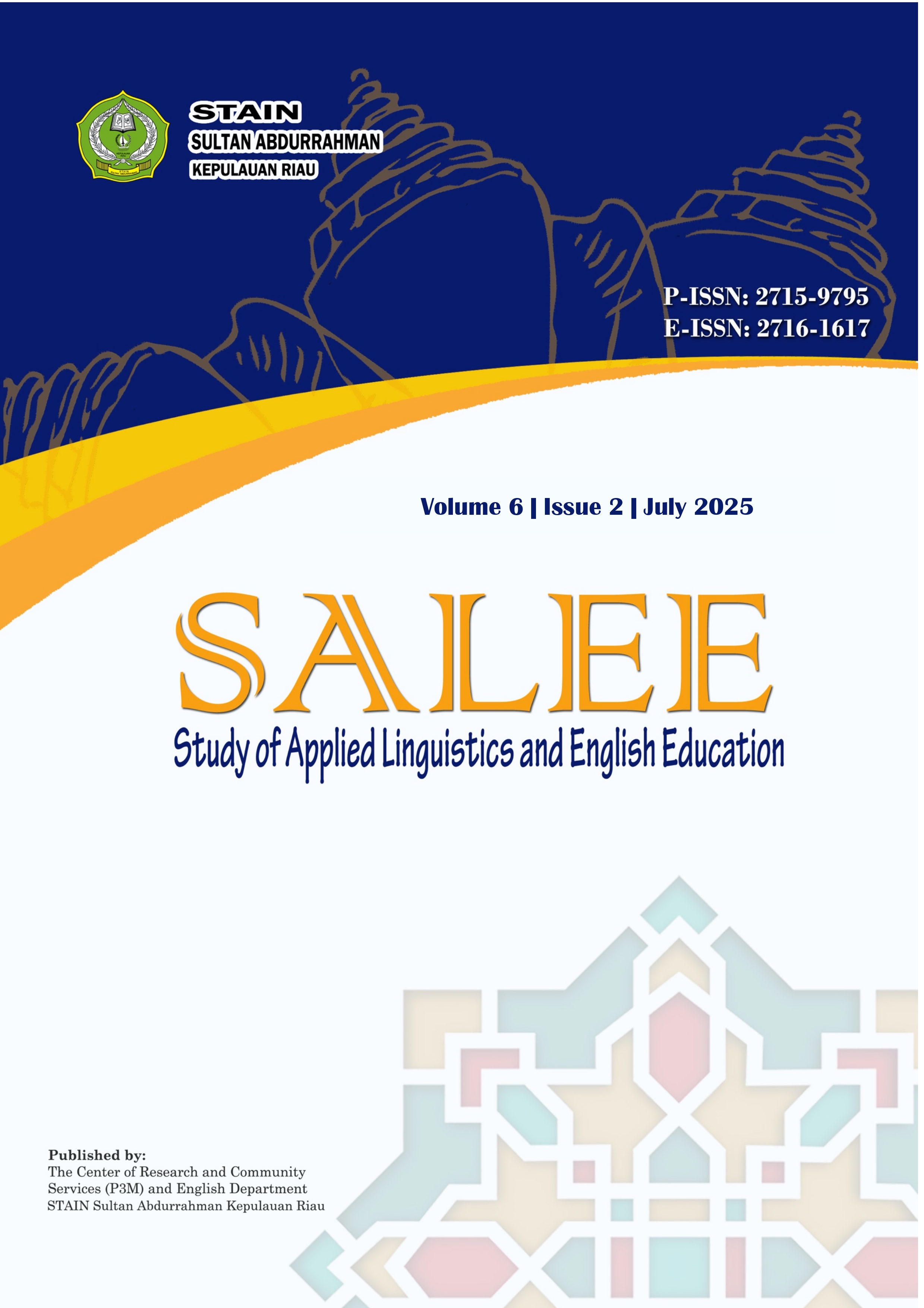Exploring Technology Use in English Pronunciation Instruction: A Systematic Review of Trends and Tools
DOI:
https://doi.org/10.35961/salee.v6i2.1931Keywords:
Computer-Assisted Pronunciation Training, Digital Tools, Language Education, Pronunciation Instruction, Technology in LearningAbstract
The integration of technology into education has reshaped pronunciation instruction, introducing innovative tools like Computer-Assisted Pronunciation Training (CAPT) and speech recognition systems. This study aims to systematically review the trends and tools used in technology-assisted pronunciation learning and evaluate their effectiveness. Employing the PRISMA protocol, 27 peer-reviewed studies published between 2006 and 2024 were analyzed through a systematic review method. The findings reveal a significant rise in the use of Computer-Assisted Pronunciation Training (CAPT), mobile applications, and speech analysis software such as Praat, Audacity, and ASR-based systems. These tools offer interactive features, immediate feedback, and personalized learning, contributing to improved phonetic accuracy across segmental and suprasegmental aspects. The majority of studies focused on learners in higher education, ranging from beginner to advanced levels. While results demonstrate the positive impact of technology on pronunciation proficiency, limitations remain in long-term impact evidence and contextual adaptation, particularly in under-resourced settings. This study underscores the potential of digital tools to complement traditional methods and recommends future research to address sustainability, accessibility, and pedagogical integration.
References
Altun, M., & Ahmad, H. K. (2021). The use of technology in English language teaching: A literature review. International Journal of Social Sciences & Educational Studies, 8(1), 226–232.
Amrate, M., & Tsai, P. H. (2024). Computer-assisted pronunciation training: A systematic review. ReCALL, 1–21. https://doi.org/10.1017/S095834402400001X
Arifah, A. (2014). Study on the use of technology in ELT classroom: Teachers’ perspective (Master’s thesis, BRAC University). http://dspace.bracu.ac.bd/handle/10361/3449
Benson, P. (2011). Teaching and researching autonomy (2nd ed.). Routledge. https://doi.org/10.4324/9781315833767
Bloom, B. S. (Ed.). (1956). Taxonomy of educational objectives: The classification of educational goals. Handbook I: Cognitive domain. David McKay.
Britten, N., Campbell, R., Pope, C., Donovan, J., Morgan, M., & Pill, R. (2002). Using meta ethnography to synthesise qualitative research: A worked example. Journal of Health Services Research & Policy, 7(4), 209–215. https://doi.org/10.1258/135581902320432732
Cámara Arenas, E., Tejedor García, C., Tomas Vázquez, C. J., & Escudero Mancebo, D. (2024). Automatic pronunciation assessment vs. automatic speech recognition: A study of conflicting conditions for L2-English. Computer Assisted Language Learning. (In press)
CASP UK. (2025). Critical Appraisal Skills Programme: Checklists and how to use them. https://casp-uk.net/casp-tools-checklists/
Chou, F. (2005). Ya-Ya language box: A portable device for English pronunciation training with speech recognition technologies. In Proceedings of Interspeech 2005 (pp. 169–172). http://www.isca-speech.org/archive_papers/interspeech_2005/i05_0169.pdf
Chu Liu, S., & Hung, P. Y. (2016). Teaching pronunciation with computer-assisted pronunciation instruction in a technological university. Universal Journal of Educational Research, 4(9), 1939–1943. https://doi.org/10.13189/ujer.2016.040901
Costley, K. C. (2014). The positive effects of technology on teaching and student learning [Online submission]. ERIC. https://eric.ed.gov/?id=ED554557
Cutter, M. (2015). Using technology with English language learners in the classroom (Master’s thesis). https://digitalcommons.brockport.edu/ehd_theses/313/
Dörnyei, Z. (2001). Motivational strategies in the language classroom. Cambridge University Press.
Eady, M. J., & Lockyer, L. (2013). Tools for learning: Technology and teaching strategies. In J. Allen (Ed.), Learning to teach in the primary school (pp. 71–89). Cambridge University Press.
Engwall, O., & Bälter, O. (2007). Pronunciation feedback from real and virtual language teachers. Computer Assisted Language Learning, 20(3), 235–262. https://doi.org/10.1080/09588220701745864
Felps, D., Ghosh, S. S., & Narayanan, S. S. (2009). A statistical model of dynamic pitch, formant, and duration features for voice conversion. IEEE Transactions on Audio, Speech, and Language Processing, 17(3), 529–542. https://doi.org/10.1109/TASL.2008.2007492
Fouz-González, J. (2015). Foreign language pronunciation training with affordable and easily accessible technologies: Podcasts, smartphone apps and social networking services (Twitter) [Doctoral dissertation, University of Murcia].
Fredricks, J. A., Blumenfeld, P. C., & Paris, A. H. (2004). School engagement: Potential of the concept, state of the evidence. Review of Educational Research, 74(1), 59–109. https://doi.org/10.3102/00346543074001059
Fryer, L., & Carpenter, R. (2006). Emerging technologies: Bots as language learning tools. Language Learning & Technology, 10(3), 8–14. http://llt.msu.edu/vol10num3/emerging/
Gerosa, M., & Giuliani, D. (2004). Preliminary investigations in automatic recognition of English sentences uttered by Italian children. In R. Delmonte et al. (Eds.), Proceedings of NLP and Speech Technologies in Advanced Language Learning Systems Symposium (pp. 9–12).
Gilakjani, A. P. (2017). A review of the literature on the integration of technology into the learning and teaching of English language skills. International Journal of English Linguistics, 7(5), 95–106. https://doi.org/10.5539/ijel.v7n5p95
Gilakjani, A. P., & Rahimy, R. (2019). Learners’ autonomy and pronunciation learning through technology. Journal of Language Teaching and Research, 10(6), 1220–1226. https://doi.org/10.17507/jltr.1006.04
Gilbert, J. B. (2012). Clear speech: Pronunciation and listening comprehension in North American English (4th ed.). Cambridge University Press.
Gustad, A. R. (2014). The impact of technology tools on literacy motivation in elementary school English language learners: Podcasting in a 4th grade EAL class. International Schools Journal, 34(1), 75–84.
Hsu, L. (2016). An empirical examination of EFL learners' perceptual learning styles and acceptance of ASR-based computer-assisted pronunciation training. Computer Assisted Language Learning, 29(5), 881–900. https://doi.org/10.1080/09588221.2015.1057615
Ilter, B. G. (2009). Effect of technology on motivation in EFL classrooms. TOJDE, 10(4), 1–10.
Krajka, J. (2001). English for Kids [Software review]. CALICO Journal, 18(3), 345–360. https://doi.org/10.1558/cj.v18i3.345-360
Lan, E. M. (2022). A comparative study of computer and mobile-assisted pronunciation training: The case of university students in Taiwan. Education and Information Technologies, 27(2), 1559–1583. https://doi.org/10.1007/s10639-021-10717-5
Levis, J. (2007). Computer technology in teaching and researching pronunciation. Annual Review of Applied Linguistics, 27, 184–202. https://doi.org/10.1017/S0267190508070098
Lin, W., & Yang, S. (2011). Exploring students’ perceptions of integrating Wiki technology and peer feedback into English writing courses. English Teaching: Practice and Critique, 10(2), 88–103.
Little, D. (1991). Learner autonomy: Definitions, issues and problems. Authentik.
Liu, S. C., & Hung, P. Y. (2016). Teaching pronunciation with computer-assisted pronunciation instruction in a technological university. Universal Journal of Educational Research, 4(9), 1939–1943.
Long, H. A., French, D. P., & Brooks, J. M. (2020). Optimising the value of the critical appraisal skills programme (CASP) tool for quality appraisal in qualitative evidence synthesis. Research Methods in Medicine & Health Sciences, 1(1), 31-42.
Mich, O., Neri, A., & Giuliani, D. (2006). The effectiveness of a computer-assisted pronunciation training system for young foreign language learners. In Proceedings of CALL 2006 (pp. 135–143). http://lands.let.ru.nl/literature/neri.2006.4.pdf
Moher, D., Liberati, A., Tetzlaff, J., Altman, D. G., & PRISMA Group. (2009). Preferred reporting items for systematic reviews and meta-analyses: The PRISMA statement. PLOS Medicine, 6(7), e1000097. https://doi.org/10.1371/journal.pmed.1000097
Murray, D. E. (2005). Technologies for second language literacy. Annual Review of Applied Linguistics, 25, 188–201. https://doi.org/10.1017/S0267190505000103
Naser, I. M., & Hamzah, M. H. (2022). Pronunciation difficulties and challenges in the field of research in Jordan. Majallat Al-Ulum Al-Ins?niyya wa al-Ijtim?'iyya, 14(6), 140–157.
Neri, A., Mich, O., Gerosa, M., & Giuliani, D. (2008). The effectiveness of computer-assisted pronunciation training for foreign language learning by children. Computer Assisted Language Learning, 21(5), 393–408. https://doi.org/10.1080/09588220802447651
Nomass, B. B. (2013). The impact of using technology in teaching English as a second language. English Language and Literature Studies, 3(1), 111–116. https://doi.org/10.5539/ells.v3n1p111
Ouni, S., Cohen, M. M., & Massaro, D. W. (2005). Training Baldi to be multilingual: A case study for an Arabic Badr. Speech Communication, 45(2), 115–137. https://doi.org/10.1016/j.specom.2004.11.008
Pennington, M. C. (1999). Computer-aided pronunciation pedagogy: Promise, limitations, directions. Computer Assisted Language Learning, 12(5), 427–440. https://doi.org/10.1076/call.12.5.427.5693
Pennington, M. C., & Rogerson-Revell, P. (2019). Using technology for pronunciation teaching, learning, and assessment. In M. C. Pennington & P. Rogerson-Revell (Eds.), English pronunciation teaching and research: Contemporary perspectives (pp. 235–286). Palgrave Macmillan.
Peregoy, S. F., & Boyle, O. F. (2012). Reading, writing, and learning in ESL: A resource book for teachers (6th ed.). Pearson.
Qian, M., Chukharev-Hudilainen, E., & Levis, J. M. (2018). A system for adaptive high-variability segmental perceptual training: Implementation, effectiveness, transfer. Computer Assisted Language Learning, 31(7), 691–717. https://doi.org/10.1080/09588221.2018.1485704
Reeve, J. (2012). A self-determination theory perspective on student engagement. In S. L. Christenson, A. L. Reschly, & C. Wylie (Eds.), Handbook of research on student engagement (pp. 149–172). Springer. https://doi.org/10.1007/978-1-4614-2018-7_7
Rodinadze, S., & Zarbazoia, K. (2012). The advantages of information technology in teaching English language. Frontiers of Language and Teaching, 3(5), 271–275.
Schwartz, S., & Pollishuke, M. (2013). Creating the dynamic classroom: A handbook for teachers (2nd ed.). Pearson Education.
Solanki, D. S., & Shyamlee, M. P. (2012). Use of technology in English language teaching and learning: An analysis. In Proceedings of the International Conference on Language, Medias and Culture (ICLMC 2012) (Vol. 33, pp. 150–156). IACSIT Press.
Surface, E., & Dierdorff, E. (2007). Special operations language training software measurement of effectiveness study: Tactical Iraqi study final report. U.S. Special Operations Command.
Thomson, R. I. (2011). Computer-assisted pronunciation training: Targeting second language vowel perception improves pronunciation. CALICO Journal, 28(3), 744–765. https://doi.org/10.11139/cj.28.3.744-765
Tsai, P. H. (2019). Beyond self-directed computer-assisted pronunciation learning: A qualitative investigation of a collaborative approach. Computer Assisted Language Learning, 32(7), 713–744. https://doi.org/10.1080/09588221.2018.1535502
Warschauer, M., & Meskill, C. (2000). Technology and second language learning. In J. W. Rosenthal (Ed.), Handbook of undergraduate second language education (pp. 303–318). Lawrence Erlbaum Associates.
Wen, Y., Li, J., Xu, H., & Hu, H. (2023). Restructuring multimodal corrective feedback through Augmented Reality (AR)-enabled videoconferencing in L2 pronunciation teaching. Computer Assisted Language Learning. https://doi.org/10.1080/09588221.2023.2198124
Zhao, Y. (2013). Recent developments in technology and language learning: Literature review and meta-analysis. CALICO Journal, 21(1), 7–27. https://doi.org/10.1558/cj.v21i1.7-27
Downloads
Published
How to Cite
Issue
Section
License
Copyright (c) 2025 Nursyafida, Reni Eka Putri

This work is licensed under a Creative Commons Attribution-ShareAlike 4.0 International License.










